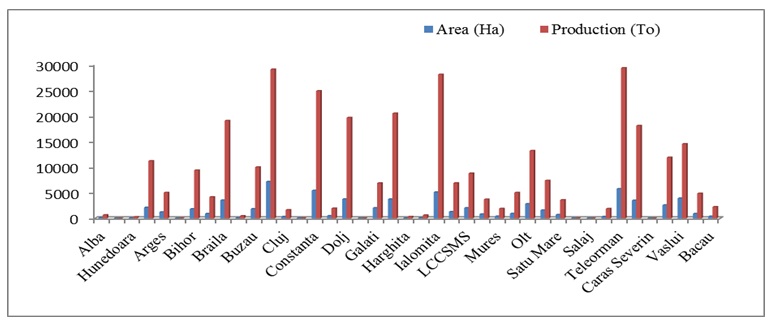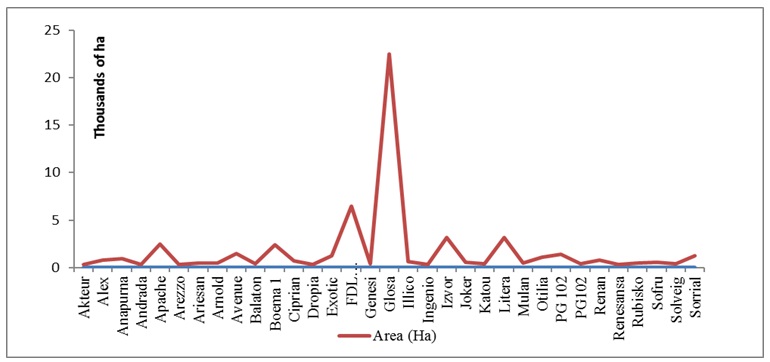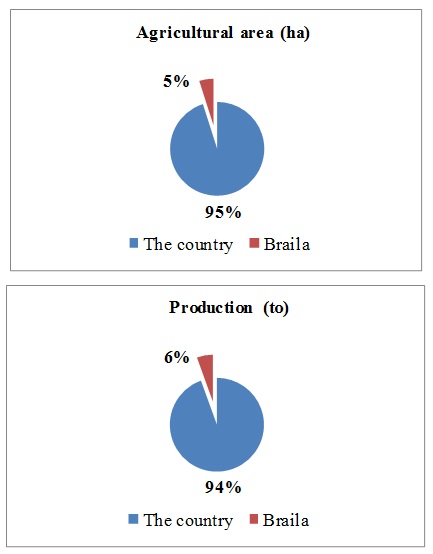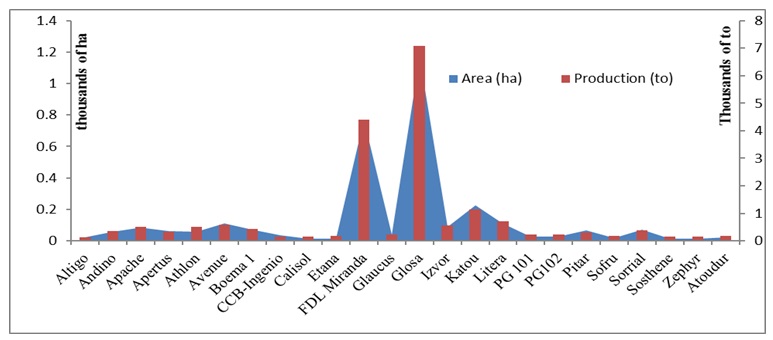Introduction
Wheat is the oldest plant grown by man, and there are data about its introduction into agriculture about ten thousand years ago in the Middle East (Charmet, 2011). Wheat cultivation has gradually expanded to different parts of Asia, Africa and Europe. Wheat was introduced to the American continent and to Australia at the end of the 18th century by European colonists (Muntean et al, 2014). Wheat is grown successfully under different pedoclimatic conditions, resulting in significant yields and high quality characteristics (Stanciu, 2017). The climate change expected for the coming decades may strongly affect the wheat crop in Romania, as wheat is a water-consuming and stress-sensitive plant during the anthesis period (Cuculeanu et al., 1999). Drought climates, although they reduce the productivity of wheat crops, they favour the accumulation of proteins in the grain, Muntean et al. (2014), mentioning the existence of a negative correlation between seed production and protein content. The Fundulea National Institute of Agricultural Research and Development (INCDA) is the main Romanian research compound in Romania, which, although facing a lot of competition from multinational companies lately, is still holding a preferential position in the Romanian farmers’ choices (Dobre, 2016). The soil, the seed, the technology used, the machinery and irrigations can optimize the ratio between the costs incurred and the value of the output produced (Băcanu et al, 2017).
Material and Methods
The items of information regarding certified areas, certified wheat varieties and yields obtained have been selected from the databases of the Ministry of Agriculture and Rural Development, Territorial Inspectorate for the Quality of Seeds and Planting Material Brăila (ITCSMS) within the National Inspection for Seed Quality (INCS). In some cases, media information was also used from journals and specialised magazines. The relevant national legislative provisions (normative acts, rules and technical regulations in force) were taken from the MADR database. For research, the Web of Science Core Collection database was mainly used, being accessed through the intranet network of ″Dunarea de Jos″ University of Galati and the Google Academic search engine. The data collected were statistically processed and graphically plotted, and the results were analysed and commented.
Literature Review
Wheat is the main cereal cultivated worldwide and is the feeding basis for a large part of the world’s population. Wheat crops can be used as whole or ground grains for food or industrial purposes. The bran resulting from the grinding of wheat grains is valuable concentrated feed rich in proteins, lipids and mineral salts (Dobre, 2017). Due to the high content of carbohydrates and proteins as well as the optimal ratio of these components, wheat is a valuable food product with high degree of assimilation and high energy value. The whole wheat grain is considered a functional food with antioxidant properties (Liangli, 2008). Generally, cereals are cheap to produce, are easily stored and transported, and do not deteriorate readily if kept dry (Brigid, 2004). The foreign investments in Romanian agriculture sector have been focused last years toward the cereal storage and trade, agricultural lands or seed trade (Stanciu, 2016a). Under the conditions of using high performance technologies, varieties with stable and good production capacity are yielding important agricultural outputs. According to ITCSMS Brăila, in 2016-2017 the areas cultivated with wheat seed lots measured 3538 ha. The survey conducted analysed the production potential for some Romanian and imported wheat varieties in Braila County. ISTIS elaborates the ″Regulation for testing and registering the Varieties and Hybrids of agricultural species″ which is approved by MADR (ISTIS,2017).
Technological criteria for choosing wheat varieties for seed
The wheat seed destined for seed lots has to be characterised by high germination indexes, showing good germination capacity and developing a vigorous plant. The weight of wheat spikes is an essential part of the production. The number of grains and the mass of one thousand grains depend on the characteristics of the variety. In order to obtain an optimum production/seed ratio, the number of germinable seeds/sqm should be quantified, so that a minimum of 500-600 plants/sqm is obtained on emergence. An important agricultural work imposed on the seed lots is the biological purification which involves the elimination of all plants other than the variety. Pursuant to Order 59/2011 for the approval of the procedures for specific requirements for the production, certification and marketing of cereal seed, oilseeds and for fibre and fodder plants in Romania, seed certification consists of a set of control and verification operations in the main stages of the process of multiplication, conditioning, packaging, labelling and sealing which are meant to make sure that the products, processes and services comply with specific rules and regulations. The cultivation of wheat varieties not adapted to growing areas implies very high expenses with the culture technology and the production will be insufficiently capitalised. Choosing a variety of wheat which can ensure the best match between the pedoclimatic resources of the area and the biological characteristics of the variety is an essential condition for the stability of high yields (Băcanu et al, 2017). A major research objective of the Fundulea National Institute of Agricultural Research and Development (INCDA) is the creation of varieties and hybrids adapted to the diversity of growing conditions in Romania, with improved qualities of capitalising on technological, stable and quality attributes corresponding to the multitude of harvest use ways (INCDA, 2017). Figure 1 shows the certified areas and productions in Romania in 2017. The main counties of the country in terms of areas cultivated for wheat seed production are Călăraşi (7176.75 ha/29,089.29 tons); Teleorman (5,767.98 ha/29,369 tons); Ialomita (5,121.97 ha/28,090.06 tons), and Braila (3,538 ha/19,071.5 tons) respectively.

Fig. 1: Agricultural areas and production for seed wheat in Romania
Source: Author, by using ITCSMS data (2018)
The quality of grain seeds is determined by the quality of the genetic material, the type of soil, the level of applied technologies, the provision of the technical – material basis (machines, fertilisers, pesticides, irrigation) and the degree of qualification, information, research and innovation of the multiplier (Băcanu et al, 2017). According to the data presented in Figure 2, we can notice that Glosa wheat variety ranks first among the seeds of cultivated areas in Romania (22476.46 ha) followed by FDL Miranda (6444.72 ha), Izvor (3131.06 ha), Litera (3189.19 ha), Boema 1 (2416.21 ha), with a great achievement of the research at Fundulea.

Fig. 2: Certified wheat varieties and areas for seed material in Romania
Source: Author, by using ITCSMS data (2018)
Areas and wheat varieties cultivated in Braila County
In 2017 in Brăila County, the area sown with seed wheat was of 3,538 ha, resulting in a production of about 19,071.5 tons. The production obtained on the level of the county represents about 6% of the national production, and the area sown with seed wheat lots represents about 5% of the total area grown in Romania.

Fig. 3: The cultivated area and the production of seed wheat in Braila county
Source: Author, by using ITCSMS data (2018)
Choosing a suitable variety adapted to drought conditions is an essential factor in growing technology. The choice of varieties resistant to thermal and water stress (drought, drought accompanied by heat) plays an important role in agriculture (Stanciu, 2016b). Choosing the best variety cannot guarantee in se good results in drought conditions if the other technological elements are not applied properly. Choosing a variety that is inappropriate for drought conditions can render investments in wheat crops only partially capitalised (Melucă et al., 2011). Even if it is in permanent competition with multinational companies, which offer farmers more and more competitive varieties and hybrids, the Fundulea Institute of Agricultural Research and Development is ranked at the top of the Romanian farmers’ choices when it comes to the wheat culture (Agrotehnica, 2016).
According to the data presented in Fig. 4, we may remark that on the level of Braila County, there was a significant increase of the areas and of the productions of wheat seeds varieties. Glosa (1238 ha, 6667 tons), FDL Miranda (772 ha, 4408 tonnes), Litera (124 ha, 634 tons) and Izvor (96 ha, 503 tons) are the main wheat varieties grown. Because the Romanian varieties exhibit a relative stability of production in the climatic conditions, Braila farmers prefer the detriment of imported varieties. Compared to them, foreign wheat varieties were cultivated on small areas (about 100 ha), the most widespread being Katou, with a production of 1280 tons, and Avenue (647 tons).

Fig. 4: Certified wheat varieties and areas in Braila County
Source: Author, by using ITCSMS data (2018)
The Glosa variety has a wide adaptability, being stable and constant in terms of production and less affected by the fluctuation of climatic conditions. According to specialists in agriculture, it is an early variety, with good resistance to fall, wintering, drought and heat or ear germination (Dobre, 2015). The attack of biological pests affects the variety only to a little extent, having a medium degree of resistance to brown rust, resistance to mildew and yellow rust (Agrotechnica, 2017). In the period 2014-2017 on the level of Brăila County, the areas where certified wheat varieties were sown ranged between 2200 and 2900 ha (table 1).
Table1: Seed-producing areas cultivated with wheat varieties in the county of Braila (ha)
Source: Author, by using ITCSMS Brăila data (2018)
The biologically controlled field material that corresponds to the purity indices can be certified as seed classified as Prebase G1, Prebase G2, Base, Certified C1, and Certified C2. The obtaining of seeds with superior qualitative features is conditioned by the scientific substantiation of the farming activity, based on the knowledge of the elements of genetics, amelioration and production, respectively with the understanding and application of modern methods of conservative selection. These items of information are necessary for the permanent maintenance of genetic structure and biological value at the initial level of varieties of agricultural plants (Pacurar et al., 2007). Table 2 presents the areas and quantities of seed from the categories Prebase G1, Prebase G2, Base, Certified C1 and Certified C2 harvested in Braila County.
Table 2: Seed-producing areas and Glosa wheat productions in Braila County 2014-2017
Source: Author, by using ITCSMS Brăila data (2018)
The area sown with the Glosa variety (1238 ha) in 2017 represents half of the total area cultivated with wheat in Romania. The varieties created by the Fundulea Institute for Agricultural Research and Development aim at ensuring the required quantities of certified seed of all biological categories.
Conclusions
The choice of varieties represents an essential factor in the crop technology, with the seed being the essential link in the production of certified seed. Braila County has a significant farming potential due to the geographical area favourable to the cultivation of straw cereals, the availability and quality of arable land, genetic material, high-performance technologies and farmers’ experience. The Romanian wheat varieties are of great importance because they are adapted to the conditions of drought, the conditions of thermal stress and water stress. The results of the study showed that on the level of Braila County, the most common varieties of wheat seeds are the native ones, better suited to the local conditions of cultivation, high temperatures and the lower level of rainfall. Of these, the most commonly used both throughout the country and in Braila County are Glosa and Miranda, are wheat varieties created by the Romanian research that have proved to have the greatest adaptability to the conditions in our country.
(adsbygoogle = window.adsbygoogle || []).push({});
References
- Agrotehnica, (2016), Soiurile de grâu, cele mai apreciate creații ale INCDA Fundulea, [online], [Retrieved January 23, 2018), https://www.lumeasatului.ro/articole-revista/agrotehnica/3053-soiurile-de-grau-cele-mai-apreciate-creatii -ale-incda-fundulea.html.
- Băcanu (Serban), C., Dinca, C., Ion, I.M., Stanciu, S.,(2017), ″Stydy on the production of wheat seeds in Brăila Country″, Proceedings of The 30th IBIMA Conference, (Madrid, Spain, 8-9.11.2017), Ed. Soliman, K.S.,3052-3060.
- Brigid McKevith, (2004), Nutritional aspects of cereals, British Nutrition Foundation, London, UK [online], [Retrieved February 24, 2018) https://www.nutrition.org.uk/attachments/207Nutritional%20aspects%20of%20 cereals.pdf
- Charmet, G., (2011), Wheat domestication: Lessons for the future, Science Direct, [online], [Retrieved February 23, 2018) https://www.sciencedirect.com/science/article/pii/S1631069110003021?via%3Dihub
- Cuculeanu V.; Marica, A.; Simota, C.,(1999),″ Climate change impacts on agricultural crops in Romania and adaptation options″, Climate Research, (CR SPECIAL 6, Book Version), 12, 153-160.
- Dobre, R., (2015), Glosa – cel mai popular soi de grâu românesc: Stabilitatea pe care o dă în producție îl menține în top, Agrointeligenta (January 19, 2016), [online], [Retrieved September 23, 2017), http://agrointel.ro/37266/glosa-cel-mai-popular-soi-de-grau-romanesc-stabilitatea-pe-care-o-da-in-productie-il-mentine-in-top.
- Dobre, R., (2016), Romanian Wheat varieties that promise in 2016: Otilia, Pajura and Pitar, Agrointeligenta (January 19, 2016), [online], [Retrieved February 23, 2018), http://agrointel.ro/47024/soiuri-romanesti-de-grau-care-promit-in-2016-otilia-pajura-si-pitar-vor-reusi-ele-sa-detroneze-glosa.
- Institutul de Stat pentru Testarea si Inregistrarea Soiurilor ISTIS, (2017), Misiunea ISTIS, [online], [Retrieved February 23, 2018), available at http://istis.ro/misiune.
- Liangli Yu, (2008), ″Wheat antioxidants″, Chapter 1. Overview and perspective, John Wiley & Sons, Inc, [online], [Retrieved February 23, 2018), https://www.wiley.com/en-us/Wheat+Antioxidants-p-9780470042595.
- Melucă, C., Cernat, S., Nistor, T., (2011). ″Comportarea unor soiuri de grâu de toamnă în condiții de stres hidric și termic în Câmpia Burnasului″. An. I.N.C.D.A. Fundulea, LXXIX (2), 201-210, [online], [Retrieved February 23, 2018), http://www.incda-fundulea.ro/anale/79.2/79.3.pdf.
- Ministry of Agriculture and Rural Development MADR, (2010), Agriculture. Legislation, http://www.madr.ro/en/agriculture.html.
- Muntean, L. S., Cernea, G., Morar, M., Duda, D. I., Varban, S., Muntean S., Moldovan C., (2014), Fitotehnie, Ed. a III-a, Ed. Risoprint, Cluj-Napoca.
- National Inspection for Quality of Seeds INCS, (2017), Official Certification Data Base, [online], [Retrieved March 01, 2018), http://date.incs.bvl.ro/agenti/Loturi10_detalii.aspx.
- Pacurar, I., Oprea, G., Salagean, D., (2007), Researches on the production of grain grains, Anale. I.N.C.D.A. Fundulea, LXXV/Volum Jubiliar, 229-244, [online], [Retrieved March 01, 2018), http://www.incda-fundulea.ro/anale/75/75.13.pdf.
- Stanciu, S., (2017),″Yields and Land Use for Wheat Production in Romanian Agriculture″, Proceedings of the 30th IBIMA Conference, (Madrid, Spain, Nov. 08-09, 2017), ISBN:978-0-9860419-9-0, Ed. KS. Soliman, I-IV, 3033-3040.
- Stanciu, S., (2016a), Crop Management. Case Study: ″Romanian Soybean Production, Review of International Comparative Management″, 17(4), 392-402.
- Stanciu, S., (2016b), The Foreign Direct Investment in the Romanian Agrifood Production″, SEA: Practical Application of Science, 2(11), 289-297.









